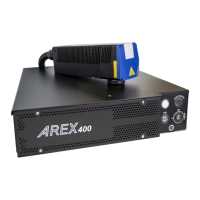Laser Safety
98
Arex™ 400
N.O.H.D. determination and O.D. of protection goggles
In order to determine the characteristics of the protection goggles, it is essential
to determine the characteristics of the radiation, knowing its optical path, the
dimensions of the beam and its divergence.
Objective
Scanning Head
Beam-Exp
Source
It is very important to know the real divergence of the laser beam at output of F-
Theta scan lens.
With all this optical data available, it is possible to calculate the Nominal Ocular
Hazard
Distance (N.O.H.D.) and the optical density (O.D.) required by the laser
radiation protection filters (goggles).
Below calculations have been done following the CEI EN 60825-1 (2014) Norma-
tive regarding nominal distance and optical ri
sk in the worst condition and in
case of accidental exposure of 10 seconds for direct radiation and 100 seconds
for diffused radiation.
Wavelength RIF
1070 nm (± 10 nm)
1065 nm (± 15 nm) for
Arex™ A20-X6X
1120 nm (Raman emission)
Laser Type
Q-Switched fiber laser
MOPA fiber laser for
Arex™ A20-X6X
Observation type Direct radiation
Pulse energy
1 mJ @ 10 kHz for
Arex™ 110-XXX
1 mJ @ 20 kHz for
Arex™ 120-XXX
1 mJ @ 30 kHz for
Arex™ 130-X6X
1 mJ @ 50 kHz for
Arex™ 150-X6X
0.75 mJ @ 30 kHz for
Arex™ A20-X6X
Pulse duration
100 ns
250 ns for
Arex™ A20-X6X
Beam Diameter at F-Theta lens exit DL ~ 6.0 mm
Beam divergence on the lens
2
0.8 mrad
Focal of the F-Theta lens F 160 mm
Real divergence after the lens
2
31.2 mrad
Exposure time 10 s
Max beam scanning angle ± 20° each axis

